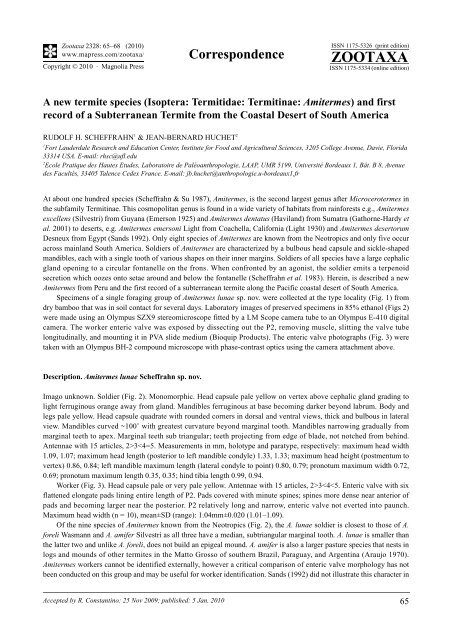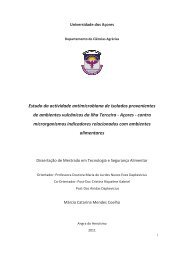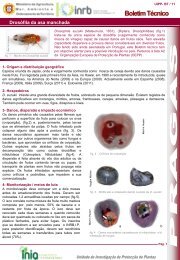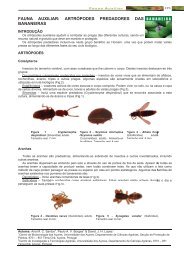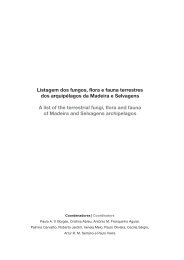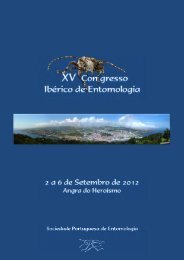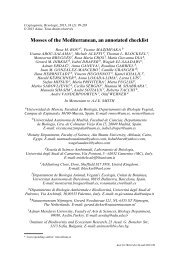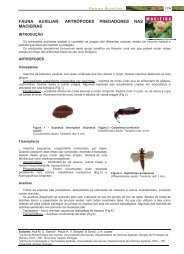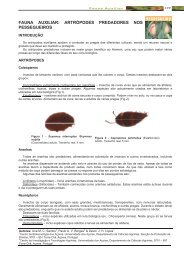Zootaxa, A new termite species (Isoptera: Termitidae ... - CITA-A
Zootaxa, A new termite species (Isoptera: Termitidae ... - CITA-A
Zootaxa, A new termite species (Isoptera: Termitidae ... - CITA-A
You also want an ePaper? Increase the reach of your titles
YUMPU automatically turns print PDFs into web optimized ePapers that Google loves.
<strong>Zootaxa</strong> 2328: 65–68 (2010)<br />
www.mapress.com/zootaxa/ Correspondence<br />
Copyright © 2010 · Magnolia Press<br />
ISSN 1175-5326 (print edition)<br />
ZOOTAXA<br />
ISSN 1175-5334 (online edition)<br />
A <strong>new</strong> <strong>termite</strong> <strong>species</strong> (<strong>Isoptera</strong>: <strong>Termitidae</strong>: Termitinae: Amitermes) and first<br />
record of a Subterranean Termite from the Coastal Desert of South America<br />
RUDOLF H. SCHEFFRAHN 1 & JEAN-BERNARD HUCHET 2<br />
1<br />
Fort Lauderdale Research and Education Center, Institute for Food and Agricultural Sciences, 3205 College Avenue, Davie, Florida<br />
33314 USA. E-mail: rhsc@ufl.edu<br />
2<br />
Ecole Pratique des Hautes Etudes, Laboratoire de Paléoanthropologie, LAAP, UMR 5199, Université Bordeaux 1, Bât. B 8, Avenue<br />
des Facultés, 33405 Talence Cedex France. E-mail: jb.huchet@anthropologie.u-bordeaux1.fr<br />
At about one hundred <strong>species</strong> (Scheffrahn & Su 1987), Amitermes, is the second largest genus after Microcerotermes in<br />
the subfamily Termitinae. This cosmopolitan genus is found in a wide variety of habitats from rainforests e.g., Amitermes<br />
excellens (Silvestri) from Guyana (Emerson 1925) and Amitermes dentatus (Haviland) from Sumatra (Gathorne-Hardy et<br />
al. 2001) to deserts, e.g. Amitermes emersoni Light from Coachella, California (Light 1930) and Amitermes desertorum<br />
Desneux from Egypt (Sands 1992). Only eight <strong>species</strong> of Amitermes are known from the Neotropics and only five occur<br />
across mainland South America. Soldiers of Amitermes are characterized by a bulbous head capsule and sickle-shaped<br />
mandibles, each with a single tooth of various shapes on their inner margins. Soldiers of all <strong>species</strong> have a large cephalic<br />
gland opening to a circular fontanelle on the frons. When confronted by an agonist, the soldier emits a terpenoid<br />
secretion which oozes onto setae around and below the fontanelle (Scheffrahn et al. 1983). Herein, is described a <strong>new</strong><br />
Amitermes from Peru and the first record of a subterranean <strong>termite</strong> along the Pacific coastal desert of South America.<br />
Specimens of a single foraging group of Amitermes lunae sp. nov. were collected at the type locality (Fig. 1) from<br />
dry bamboo that was in soil contact for several days. Laboratory images of preserved specimens in 85% ethanol (Figs 2)<br />
were made using an Olympus SZX9 stereomicroscope fitted by a LM Scope camera tube to an Olympus E-410 digital<br />
camera. The worker enteric valve was exposed by dissecting out the P2, removing muscle, slitting the valve tube<br />
longitudinally, and mounting it in PVA slide medium (Bioquip Products). The enteric valve photographs (Fig. 3) were<br />
taken with an Olympus BH-2 compound microscope with phase-contrast optics using the camera attachment above.<br />
Description. Amitermes lunae Scheffrahn sp. nov.<br />
Imago unknown. Soldier (Fig. 2). Monomorphic. Head capsule pale yellow on vertex above cephalic gland grading to<br />
light ferruginous orange away from gland. Mandibles ferruginous at base becoming darker beyond labrum. Body and<br />
legs pale yellow. Head capsule quadrate with rounded corners in dorsal and ventral views, thick and bulbous in lateral<br />
view. Mandibles curved ~100˚ with greatest curvature beyond marginal tooth. Mandibles narrowing gradually from<br />
marginal teeth to apex. Marginal teeth sub triangular; teeth projecting from edge of blade, not notched from behind.<br />
Antennae with 15 articles, 2>33
his African Amitermes revision. Photographs of the enteric valve (Fig. 3) are the first for Amitermes and are meant to<br />
stimulate such studies.<br />
FIGURE 1. Type locality of A. lunae. Red arrow indicates location where this <strong>species</strong> was collected from bamboo lying<br />
on the soil (photo by C. Chauchat).<br />
The holotype and paratype soldiers and 17 type series workers (UF vial code PE-171) are deposited, respectively, in<br />
the University of Florida Termite Collection (Ft. Lauderdale Research and Education Center, Fort Lauderdale, Florida)<br />
and the Florida Collection of Arthropods (Florida Department of Agriculture and Consumer Services, Division of Plant<br />
Industry, Gainesville, Florida). The remaining 34 type series workers are equally divided between the Muséum National<br />
d'Histoire Naturelle, Paris, and the private collection of JBH. Amitermes lunae is named for its type and only known<br />
locality, the Huaca de la Luna archeological site.<br />
A single foraging group of A. lunae consisting of two soldiers and 51 workers was collected by JBH on 5 June 2009<br />
at Huaca de la Luna archeological site near Trujillo, Peru (-8.135, -78.991, 57 m elevation, 5.5 km from the coast). We<br />
expect that this <strong>species</strong> will be found in similar localities ranging from extreme southwestern Ecuador, the Sechura and<br />
Peruvian deserts, and possibly south into the Atacama desert of Chile.<br />
With the exception of Cuba, Amitermes is a mainland <strong>species</strong> with A. beaumonti Banks being common in humic<br />
localities from the Yucatan to Panama. In South America, A. foreli Wasmann is a dominant mound building <strong>species</strong> in<br />
pastures and grasslands of northern Colombia and western Venezuela. Amitermes amicki Scheffrahn, described from the<br />
arid island of Aruba, is sympatric with or replaces A. foreli in the deserts around Barranquilla and the Guajira peninsula<br />
in Colombia to the Paraguaná peninsula and Barquisimeto in northern Venezuela. The three remaining described <strong>species</strong><br />
in South America, are A. excellens, A. aporema Constantino, and A. amifer Silvestri. The first two are Amazonian <strong>species</strong><br />
and A. amifer occurs in the Gran Chaco of Argentina, Paraguay and the Matto Grosso of Brazil.<br />
Amitermes lunae was collected in order to identify the <strong>termite</strong> responsible for osteophagy of the skeletal remains of<br />
a Moche woman at Huaca de la Luna (Huchet et al. in press). In a more recent 2009 grave excavation where bone<br />
66 · <strong>Zootaxa</strong> 2328 © 2010 Magnolia Press<br />
SCHEFFRAHN & HUCHET
consumption was evident (left femur diaphysis), the remains of sub-fossil Amitermes head capsules were discovered<br />
close to the skeleton. Additionally, a nearly complete sub-fossil of an Amitermes worker was found inside a small bone<br />
fragment. The latter was identified as Amitermes based on generic level dentition patterns of both worker mandibles<br />
(Huchet, unpublished). At the same site, JBH also collected Cryptotermes brevis (Walker) infesting structural bamboo.<br />
This extends the endemic range of C. brevis north from the Lima vicinity (Scheffrahn et al. 2009).<br />
The Peruvian and Atacama deserts (-5 to -30˚) is one of the few regions on earth were little or no rainfall occurs.<br />
Plant life, however, is supported by riparian habitats from Andean runoff and isolated lomas communities which receive<br />
their moisture in the form of fog-deposited dew (Rundel et al. 2007). The Huaca de la Luna site is adjacent to the Moche<br />
River where groundwater supports native vegetation and agricultural irrigation has extended plant growth well beyond<br />
the river banks. As noted before, some Amitermes <strong>species</strong> are suited for desert habitats, however, no subterranean<br />
<strong>termite</strong>s have been reported from localities with as little precipitation as at the Huaca de la Luna site.<br />
FIGURE 2. Left: Ventral, dorsal, and lateral habitus of holotype soldier of A. lunae. Bar = 1 mm. Right: Neotropical<br />
Amitermes soldier headcapsules: A. A. cryptodon Light, Rabinal, Guatemala; B. A. amicki, Taratara, Venezuela, C. A.<br />
beaumonti, La Ceiba, Guatemala ; D. A. excellens, El Callo, Venezuela, E. A. foreli, Barquisimeto, Venezuela, F. A. lunae<br />
sp. nov., holotype; G. A. amifer Coxipo, Brazil (redrawn from Light 1932) ; H. A. aporema, Aporema, Brazil (redrawn<br />
from Constantino 1992) ; I. A. ensifer Light, Jala, Mexico (redrawn from Light 1930). Scale bar = 1mm.<br />
Acknowledgments<br />
We would like to thank Dr. C. Chauchat ("Archéologie des Amériques ", UMR 8096, Centre National de la Recherche<br />
Scientifique), director of the French archeological mission at Huaca de la Luna for permitting JBH to conduct<br />
entomological investigations at this site and Dr. B. Maureille (head of the Laboratoire d’Anthropologie des Populations<br />
du Passé (University of Bordeaux I) for partially supporting the field research in Trujillo, Peru. We are also indebted to<br />
Belkys Gutiérrez, Prof. Segundo Vásquez, and our colleagues in the Department of Biological Sciences (Universidad<br />
Nacional de Trujillo, Perú) for field support and logistics while in Peru.<br />
NEW AMITERMES FROM PERU<br />
<strong>Zootaxa</strong> 2328 © 2010 Magnolia Press · 67
FIGURE 3. Enteric valve cuticular lining of A. lunae worker. Left: five pads shown, one pad bisected along slit line. Bar<br />
= 0.2mm. Right: close up of bottom pads. Bar = 0.05.<br />
References<br />
Araujo, R.J. (1970) Termites of the neotropical region. In: Krishna, K. & F. M. Weesner (eds.), Biology of Termites, Vol.<br />
1. Academic Press, New York, pp. 527–576.<br />
Constantino, R. (1992) A New Species of Amitermes Silvestri from The Amapá State, Brazil (<strong>Isoptera</strong>, <strong>Termitidae</strong>,<br />
Termitinae). Boletim do Museu Paraense Emílio Goeldi Série Zoologia, 8, 337–341.<br />
Emerson, A.E. 1925. The <strong>termite</strong>s from Kartabo, Bartica District, Guyana. Zoology, 6, 291–459.<br />
Gathorne-Hardy, F., Syaukani & Eggleton, P. (2001) The effects of altitude and rainfall on the composition of the<br />
<strong>termite</strong>s (<strong>Isoptera</strong>) of the Leuser Ecosystem (Sumatra, Indonesia). Journal of Tropical Ecology, 17, 379–393.<br />
Huchet, J.-B., Deverly, D., Gutierrez, B. & Chauchat, C. (in press). Taphonomic evidence of an human skeleton gnawed<br />
by <strong>termite</strong>s in a Moche-civilisation grave at Huaca de la Luna, Peru. International Journal of Osteoarchaeology, 20<br />
(DOI: 10.1002/oa.1110).<br />
Light, S.F. (1930) The Mexican <strong>species</strong> of Amitermes Silvestri (<strong>Isoptera</strong>). University of California Publications in<br />
Entomology, 5, 215–232.<br />
Light, S.F. (1932) Contribution toward a revision of the American <strong>species</strong> of Amitermes Silvestri. University of<br />
California Publications in Entomology, 5, 355–414.<br />
Rundel, P.W., Villagra, P., Dillon, M., Roig-Junent, S. & Debandi, G. (2007) Arid and semi-arid ecosystems. In: Veblen,<br />
T., Young, K.R. & Orme, A.R. (eds.), The physical geography of South America. Oxford University Press, New<br />
York, pp. 158– 183.<br />
Sands, W. (1992) The <strong>termite</strong> genus Amitermes in Africa and the Middle East. Bulletin of the Natural Resources<br />
Institute, United Kingdom, 51, 1–140.<br />
Scheffrahn R., Gaston, L., Sims, J. & Rust, M. (1983) Identification of the defensive secretion from soldiers of the North<br />
American <strong>termite</strong>, Amitermes wheeleri (Desneux) (<strong>Isoptera</strong>: <strong>Termitidae</strong>). Journal of Chemical Ecology, 9, 1293–<br />
1305.<br />
Scheffrahn, R., Křeček, J., Ripa, R. & Luppichini, P. (2009) Endemic origin and vast anthropogenic dispersal of the West<br />
Indian drywood <strong>termite</strong>. Biological Invasions , 11, 787–799.<br />
Scheffrahn, R. & Su, N.-Y. (1987) A world list of <strong>species</strong> in the genus Amitermes (<strong>Isoptera</strong>: <strong>Termitidae</strong>). Sociobiology,<br />
13, 183–190.<br />
68 · <strong>Zootaxa</strong> 2328 © 2010 Magnolia Press<br />
SCHEFFRAHN & HUCHET


